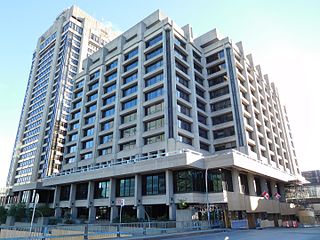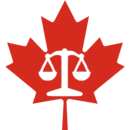A patent attorney is an attorney who has the specialized qualifications necessary for representing clients in obtaining patents and acting in all matters and procedures relating to patent law and practice, such as filing patent applications and oppositions to granted patents.
Under United States patent law, a continuing patent application is a patent application that follows, and claims priority to, an earlier-filed patent application. A continuing patent application may be one of three types: a continuation, divisional, or continuation-in-part. Although continuation and continuation-in-part applications are generally available in the U.S. only, divisional patent applications are also available in other countries, as such availability is required under Article 4G of the Paris Convention.

The Canadian Intellectual Property Office is responsible for the administration and processing of the greater part of intellectual property (IP) in Canada. CIPO's areas of activity include patents, trademarks, copyright, industrial designs and integrated circuit topographies. Structurally, CIPO functions as a special operating agency (SOA) under Innovation, Science and Economic Development Canada. CIPO is based in Gatineau, Quebec, part of the National Capital Region. CIPO’s current interim Chief Executive Officer is Konstantinos Georgaras.
Patent prosecution describes the interaction between applicants and their representatives, and a patent office with regard to a patent, or an application for a patent. Broadly, patent prosecution can be split into pre-grant prosecution, which involves arguing before, and sometimes negotiation with, a patent office for the grant of a patent, and post-grant prosecution, which involves issues such as post-grant amendment and opposition.
In most patent laws, unity of invention is a formal administrative requirement that must be met for a patent application to proceed to grant. An issued patent can claim only one invention or a group of closely related inventions. The purpose of this requirement is administrative as well as financial. The requirement serves to preclude the possibility of filing one patent application for several inventions, while paying only one set of fees. Unity of invention also makes the classification of patent documents easier.
The term of a patent is the maximum time during which it can be maintained in force. It is usually expressed in a number of years either starting from the filing date of the patent application or from the date of grant of the patent. In most patent laws, annuities or maintenance fees have to be regularly paid in order to keep the patent in force. Thus, a patent may lapse before its term if a renewal fee is not paid in due time.
The United States is considered to have the most favorable legal regime for inventors and patent owners in the world. Under United States law, a patent is a right granted to the inventor of a (1) process, machine, article of manufacture, or composition of matter, (2) that is new, useful, and non-obvious. A patent is the right to exclude others, for a limited time from profiting from a patented technology without the consent of the patent holder. Specifically, it is the right to exclude others from: making, using, selling, offering for sale, importing, inducing others to infringe, applying for an FDA approval, and/or offering a product specially adapted for practice of the patent.
The Trademark Trial and Appeal Board (TTAB) is an administrative tribunal within the United States Patent and Trademark Office (USPTO). The TTAB is empowered to determine the right to register a trademark. It has no authority to determine the right to use one, nor broader questions of infringement, unfair competition, damages or injunctive relief. The TTAB decides ex parte appeals from decisions by USPTO Examiners denying registration of marks, and inter partes proceedings challenging the registration of marks. Decisions of the TTAB may be appealed to a United States district court, or to the United States Court of Appeals for the Federal Circuit.
Maintenance fees or renewal fees are fees paid to maintain a granted patent in force. Some patent laws require the payment of maintenance fees for pending patent applications. Not all patent laws require the payment of maintenance fees and different laws provide different regulations concerning not only the amount payable but also the regularity of the payments. In countries where maintenance fees are to be paid annually, they are sometimes called patent annuities.
An opposition proceeding is an administrative process available under the patent and trademark law of many jurisdictions which allows third parties to formally challenge the validity of a pending patent application, of a granted patent, or of a trademark.
The Manual of Patent Examining Procedure (MPEP) is published by the United States Patent and Trademark Office (USPTO) for use by patent attorneys and agents and patent examiners. It describes all of the laws and regulations that must be followed in the examination of U.S. patent applications, and articulates their application to an enormous variety of different situations. The MPEP is based on Title 37 of the Code of Federal Regulations, which derives its authority from Title 35 of the United States Code, as well as on case law arising under those titles. The first version of the MPEP was published in 1920 by the Patent and Trademark Office Society.
In the United States, an Office action is a document written by an examiner in a patent or trademark examination procedure and mailed to an applicant for a patent or trademark. The expression is used in many jurisdictions.
In order to be registered as a patent agent or patent attorney in the United States, one must pass the United States Patent and Trademark Office (USPTO) registration examination, officially called the Examination for Registration to Practice in Patent Cases Before the United States Patent and Trademark Office and known informally as the patent bar.
Title 35 of the United States Code is a title of United States Code regarding patent law. The sections of Title 35 govern all aspects of patent law in the United States. There are currently 37 chapters, which include 376 sections, in Title 35.
The Trademark Manual of Examining Procedure (TMEP) is a manual published by the United States Patent and Trademark Office (USPTO) for use by trademark attorneys and trademark examiners. It describes all of the laws and regulations that must be followed in order to apply for and maintain a trademark in the United States. It includes explanations of the trademark application and examination process, the various types of trademarks, the Madrid Protocol, and proceedings before the Trademark Trial and Appeal Board.
The Guidelines for Examination in the European Patent Office are general instructions, for the examiners working at the European Patent Office (EPO) as well as for the parties interacting with the EPO, on the practice and procedure at the EPO in the various aspects of the prosecution of European patent applications and European patents. The Guidelines have been adopted, effective as at 1 June 1978, by the President of the EPO in accordance with Article 10(2)(a) EPC.

In Canadian patent law, only “inventions” are patentable. Under the Patent Act, only certain categories of things may be considered and defined as inventions. Therefore, if a patent discloses an item that fulfills the requirements of novelty, non-obviousness and utility, it may nonetheless be found invalid on the grounds that it does not fall within one of the statutory categories of “invention”. Since the Patent Act, the categories of patentable subject matter have been defined and interpreted by Canadian courts.
Neither computers nor software are specifically mentioned in the Canadian Patent Act. Canadian courts have held that the use of a computer in an invention neither lends, nor reduces patentability. Therefore, that an invention involves a computer is not determinative of patentability; instead, whether a computer-using invention is patentable turns on whether that invention meets the general requirements for patentability as would apply to any invention.
The Patent Trial and Appeal Board (PTAB) is an administrative law body of the United States Patent and Trademark Office (USPTO) which decides issues of patentability. It was formed on September 16, 2012, as one part of the America Invents Act. Prior to its formation, the main judicial body in the USPTO was the Board of Patent Appeals and Interferences (BPAI).


